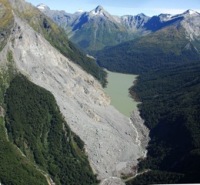Special Program for International Students
GRADUATE COURSE IN EARTH SCIENCE
& GEOENVIRONMENTAL SCIENCE
Current MEXT students
Chukwueloka Austin Okeke (Nigeria)
Email: elo_destiny @yahoo.com; s119214 @matsu.shimane-u.ac.jp
Thesis title: Mechanism and prediction of landslide dam failure due to the piping phenomenon.
Supervisor: Prof. Fawu Wang (2011-2013).
Landslide dams are common geoenvironmental hazards that occur as a result of intense seismic, tectonic and climatic activities within a geomorphic setting. Landslide dams differ from artificial dams in terms of their composition, construction and geometry. They are typically composed of unconsolidated and poorly sorted materials, and obviously have no geotechnical design to prevent piping, and seepages, or channelled spillways or other outlets to mitigate overflows. Consequently, they are often prone to rapid failure and breaching.
The mode of failure of landslide dams is very similar to that observed for artificial earth dams, with failure by overtopping, and piping or slope failure (Costa and Schuster, 1988). Overtopping occurs when water from upstream of the dam spills over the dam crest and erodes a channel on the downstream face. In contrast, failure by piping occurs when water percolates through the dam, initiating internal erosion. This causes development of ‘pipes’ that first appear as springs or seepages on the downstream face. The pipes enlarge and erode headward, flow rate increases, and a channel is eroded on the downstream dam face. Removal of support from the dam crest by the growing pipe usually results in its collapse and the development of an open breach. (Ermini and Casagli, 2002).
Aims of Study:
This research is aimed at carrying out detailed laboratory and field investigations on the mechanism of dam failure by piping, and development of models that can be used to predict dam longevity and stability. I will also study the relationship between the textural composition of landslide dams and the piping phenomenon in detail.
Specific Objectives
- To study the mechanism of landslide dam failure due to the piping phenomenon in detail using flume box experiments.
- To combine slope stability and seepage flow models in predicting landslide dam stability and longevity.
- To propose a hazard management procedure after the formation of landslide dams.
Significance:
Little or no research has been done on landslide dam failure by piping. A Comprehensive research on this project will provide a better understanding on the mechanism of dam failure by piping, and thus, provide information for precise engineering modifications of dams, and issuance of early warning and mitigation plans before the failure of landslide dams.


